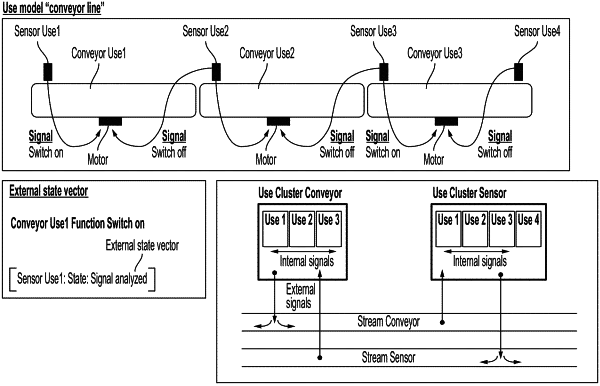| CPC G06F 30/20 (2020.01) [G06F 9/4498 (2018.02); G06F 2111/02 (2020.01)] | 19 Claims |

|
1. A method of running a virtual twin engine, executed by a computer, for control of a distributed event-discrete system in real-time, wherein the virtual twin engine has installed at least one executable modeling software kernel which is prepared by:
generating a meta model representation for at least one subsystem of a distributed event-discrete system by selecting from a meta model a meta object type (MO●) referencing at least one state model (Σi●i ∈{1, . . . , s}) for modeling of the at least one subsystem of the distributed event-discrete system, wherein at least one state (zi●k) in the at least one state model (Σi●i ∈{1, . . . , s}) is described with a meta model comprising a set of partial states (zi●k,p) using different levels of data abstraction according to set of meta features characterizing a state in a meta description domain, a set of target features having discrete or continuous range of values characterizing a target for a considered state, and a set of actual features having discrete or continuous range of values characterizing an actual constellation of a considered state;
partitioning the distributed event-discrete system into at least two subsystem clusters each comprising at least one subsystem of the distributed event-discrete system having a same meta model representation;
defining a routing topology for exchange of streaming messages between subsystem clusters;
modeling at least one subsystem use cluster for at least one subsystem assigned to a subsystem cluster of the distributed event-discrete system; and
configuring the at least one executable modeling software kernel to run the routing topology and at least one subsystem use model in relation to every subsystem use of the subsystem cluster through parametrization of executable software available from a software library,
the method of running the virtual twin engine comprising:
running in real time at least one subsystem use model in relation to the subsystem cluster through execution of a related modeling software kernel modeling the at least one subsystem use model;
operating at least one digital twin with respect to the at least one subsystem use model as a virtual counterpart to a related process object operated in the distributed event-discrete system and having a functionality corresponding to the at least one subsystem use model;
controlling data exchange to/from the virtual twin engine by classifying communication data according to different levels of abstraction into at least control data flow and/or use data flow; and
controlling the control data flow by evaluating at least one state vector representing at least one trigger event for at least one state transition of a digital twin.
|